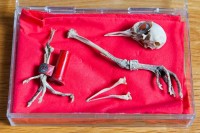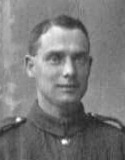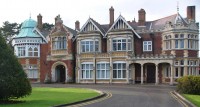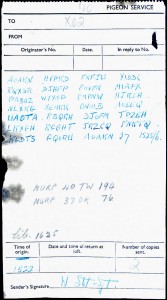 In 1982, David Martin and his wife Anne were renovating the fireplace in their 17th century house in Bletchingley, Surrey. The fireplace had been sealed off for many years, and the Martins wanted to restore it to its former functional splendor. They removed the asbestos protective liner and behind it found the original Victorian fireplace. Excited by the find, they began to clear out the chimney, which had for years been the home of birds who had packed it with twigs and nesting materials. As they pulled out the twig stuffing, bird bones came down with it, first a breastbone, then a skull, then a leg with an aluminium ring around it. The ring made them realize these weren’t the remains of a lazy old nesting bird, but rather a gainfully employed one like a racing pigeon. Then the second leg came down and it had a red plastic capsule attached to it. The red color of the capsule marked the bird as a military carrier pigeon for the Allied Forces in World War II.
In 1982, David Martin and his wife Anne were renovating the fireplace in their 17th century house in Bletchingley, Surrey. The fireplace had been sealed off for many years, and the Martins wanted to restore it to its former functional splendor. They removed the asbestos protective liner and behind it found the original Victorian fireplace. Excited by the find, they began to clear out the chimney, which had for years been the home of birds who had packed it with twigs and nesting materials. As they pulled out the twig stuffing, bird bones came down with it, first a breastbone, then a skull, then a leg with an aluminium ring around it. The ring made them realize these weren’t the remains of a lazy old nesting bird, but rather a gainfully employed one like a racing pigeon. Then the second leg came down and it had a red plastic capsule attached to it. The red color of the capsule marked the bird as a military carrier pigeon for the Allied Forces in World War II.
“I wonder if there’s a secret message,” mused Mrs. Martin, and lo and behold, when they unscrewed the capsule they found a secret message inside. It was written in code, 27 groups of five letters or numbers, on thin paper the size of a cigarette paper. The only parts immediately readable were the number of copies sent (two; the copy went by this one’s companion bird) and the name of the sender, Serjeant W. Stot (the “j” in “serjeant” suggests Stot was with the RAF rather than the Army, which usually spelled the rank with a “g”) [EDIT: The so-called expert in the article who made this claim was wrong. “Serjeant” is associated with the Army.)
The Martins showed the message to a neighbor of theirs, Secret Agent Commander Wilfred “Biffy” Dunderdale, a counter-espionage specialist who had worked for the British Secret Intelligence Service between 1921 and 1959. A lover of fast cars and faster women, Dunderdale was the Paris station chief for SIS (later called MI6). He was a regular for lunch at  Maxim’s, wore bespoke suits and solid gold Cartier cufflinks, smoked Balkan brand cigarettes in a long black ebony holder and drove a massive armour-plated Rolls-Royce around town while working (theoretically) undercover. Ian Fleming, then a rookie Naval Intelligence operative, met Dunderdale in Paris in 1940. After the war they were members of the same club, Boodle’s in St. James’s Street, where Dunderdale would regale the assembled with tales of his daring exploits. His larger-than-life personality and adventures, including smuggling two German Enigma encoding machines from Poland to Paris to London in 1939, were among Fleming’s sources for the character of James Bond.
Maxim’s, wore bespoke suits and solid gold Cartier cufflinks, smoked Balkan brand cigarettes in a long black ebony holder and drove a massive armour-plated Rolls-Royce around town while working (theoretically) undercover. Ian Fleming, then a rookie Naval Intelligence operative, met Dunderdale in Paris in 1940. After the war they were members of the same club, Boodle’s in St. James’s Street, where Dunderdale would regale the assembled with tales of his daring exploits. His larger-than-life personality and adventures, including smuggling two German Enigma encoding machines from Poland to Paris to London in 1939, were among Fleming’s sources for the character of James Bond.
After he retired from the Service, Biffy moved a few doors down from the Martins in Bletchingley.
Mr Martin recalls: “When I showed him the bird and code the blood drained from his face and he advised us to back off. He said nothing would ever be published.”
Can you even stand how juicy that is? I cannot. I cannot stand how juicy that is.
Anyway, it seemed that Biffy’s dire prognostication might come to pass as the years went by and nobody official could be persuaded to give a damn. In 1982, Britain was mired in the Falklands War and they weren’t interested in figuring out what a now-dessicated carrier pigeon had been trying to tell them 40 years earlier. It was the pigeon fancier community, from the Royal Pigeon Racing Association to military carrier pigeon aficionados, that kept hope alive, working for years to get the government to pay attention to this find.
 Two years ago, Bletchley Park, the headquarters of British Intelligence codebreakers during World War II and now a museum, took an interest in the message. Although they have not yet broken the code, they have found out that this message is something special. Bletchley Park had a classified MI6 pigeon loft during the war, but none of its messages were sent in code. Colin Hill, curator of Bletchley Park’s permanent Pigeons at War exhibition, said all of the pigeon messages they have in their archives were written longhand. That means this bird was carrying a message more secret than the actual codebreakers’ messages.
Two years ago, Bletchley Park, the headquarters of British Intelligence codebreakers during World War II and now a museum, took an interest in the message. Although they have not yet broken the code, they have found out that this message is something special. Bletchley Park had a classified MI6 pigeon loft during the war, but none of its messages were sent in code. Colin Hill, curator of Bletchley Park’s permanent Pigeons at War exhibition, said all of the pigeon messages they have in their archives were written longhand. That means this bird was carrying a message more secret than the actual codebreakers’ messages.
Also, underneath the coded message are two lines which note the code numbers of two birds. NURP 40TW194 and NURP 37DK76 were the military carrier pigeon which landed in the Martins’ chimney and its companion bird who would have carried the same message. The fact that they doubled up underscores how important this top secret message must have been, as does the complete absence of either of these birds’ code numbers from the historical archives. The birds themselves were top secret!
 Bletchingley is half-way between the beaches of Normandy and Bletchley Park, a suitable spot for a weary pigeon hero to have a rest on a chimney top only to find himself overcome by the fumes and fall inside. It’s also only five miles from Field Marshal Montgomery’s headquarters at Reigate, Surrey, where he planned the D-Day landings at Normandy. Given Winston Churchill’s insistence on a complete radio blackout for the D-Day operations, this pigeon could well have been carrying a message for the general from the front lines at Normandy.
Bletchingley is half-way between the beaches of Normandy and Bletchley Park, a suitable spot for a weary pigeon hero to have a rest on a chimney top only to find himself overcome by the fumes and fall inside. It’s also only five miles from Field Marshal Montgomery’s headquarters at Reigate, Surrey, where he planned the D-Day landings at Normandy. Given Winston Churchill’s insistence on a complete radio blackout for the D-Day operations, this pigeon could well have been carrying a message for the general from the front lines at Normandy.
When they realized the message was unique and potentially of great historical significance, Bletchley Park curators sent it to Government Communications Headquarters (GCHQ) so the current crop of codebreakers could set about deciphering it. Now that this story has finally made the press, GCHQ has been asked for any further information they might have about the message. They won’t comment on it, even on whether it was top secret, until the code is broken.
The National Pigeon Service deployed 250,000 pigeons to send messages during World War II. Thirty-two of them received the Dickin Medal, the highest possible decoration for valor that can be awarded to an animal. Perhaps 40TW194 can be posthumously granted the medal for giving his life in service to his country.
This BBC story starts with a nice period Pathé newsreel about the pigeon squadrons, then moves on to the Martins’ fireplace and the historical treasure within.
[youtube=http://www.youtube.com/watch?v=fkYhb-vobBw&w=430]